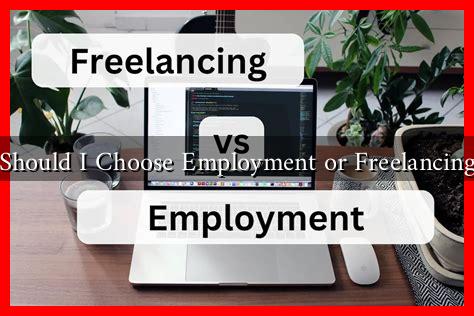-
Table of Contents
Should I Choose Employment or Freelancing?
In today’s dynamic job market, the choice between traditional employment and freelancing has become increasingly relevant. Each path offers unique advantages and challenges, making it essential for individuals to weigh their options carefully. This article explores the key factors to consider when deciding between employment and freelancing, providing insights to help you make an informed choice.
Understanding Employment
Traditional employment typically involves working for a company or organization, where you receive a regular paycheck, benefits, and job security. Here are some of the primary characteristics of employment:
- Stability: Employees often enjoy a stable income and predictable work hours.
- Benefits: Many employers offer health insurance, retirement plans, and paid time off.
- Career Development: Companies often provide training and opportunities for advancement.
- Work Environment: Employees usually work in a structured environment with set policies and procedures.
According to the U.S. Bureau of Labor Statistics, as of 2022, about 80% of the workforce is employed in traditional jobs, highlighting the prevalence of this model. However, the security of employment can come at the cost of flexibility and autonomy.
The Allure of Freelancing
Freelancing, on the other hand, offers a different set of advantages. Freelancers are self-employed individuals who provide services to clients on a project basis. Here are some key features of freelancing:
- Flexibility: Freelancers can choose their projects, clients, and work hours.
- Autonomy: Freelancers have the freedom to work independently and make their own decisions.
- Diverse Opportunities: Freelancers can work on various projects across different industries, enhancing their skills and experience.
- Potential for Higher Earnings: Successful freelancers can often charge higher rates than their salaried counterparts.
According to a report by Upwork, 36% of the U.S. workforce is freelancing, and this number is expected to grow as more people seek flexible work arrangements. However, freelancing also comes with its own set of challenges.
Key Considerations When Choosing Between Employment and Freelancing
When deciding between employment and freelancing, consider the following factors:
- Financial Stability: Evaluate your financial situation. Freelancers may experience income fluctuations, while employees typically have a steady paycheck.
- Work-Life Balance: Consider how much flexibility you need. Freelancers often have more control over their schedules, but they may also work longer hours to meet deadlines.
- Job Security: Employment often provides more job security, while freelancing can be unpredictable.
- Career Goals: Think about your long-term career aspirations. If you seek rapid advancement, traditional employment may offer more structured paths.
Case Studies: Employment vs. Freelancing
To illustrate the differences between employment and freelancing, consider the following case studies:
Case Study 1: Sarah, the Corporate Employee
Sarah works as a marketing manager for a large corporation. She enjoys a stable salary, health benefits, and opportunities for professional development. However, she often feels constrained by corporate policies and longs for more creative freedom.
Case Study 2: John, the Freelance Graphic Designer
John is a freelance graphic designer who enjoys the flexibility of choosing his projects and clients. While he has the potential to earn more than he would in a traditional job, he faces challenges such as inconsistent income and the need to manage his own health insurance and retirement savings.
Conclusion: Making the Right Choice for You
Ultimately, the decision between employment and freelancing depends on your personal circumstances, career goals, and lifestyle preferences. If you value stability, benefits, and a structured work environment, traditional employment may be the right choice for you. Conversely, if you seek flexibility, autonomy, and diverse opportunities, freelancing could be a better fit.
As the workforce continues to evolve, it’s essential to stay informed about trends and opportunities in both employment and freelancing. For more insights on freelancing and employment trends, consider visiting Upwork or the U.S. Bureau of Labor Statistics.
In conclusion, take the time to assess your priorities and make a choice that aligns with your values and aspirations. Whether you choose employment or freelancing, both paths can lead to fulfilling and successful careers.


